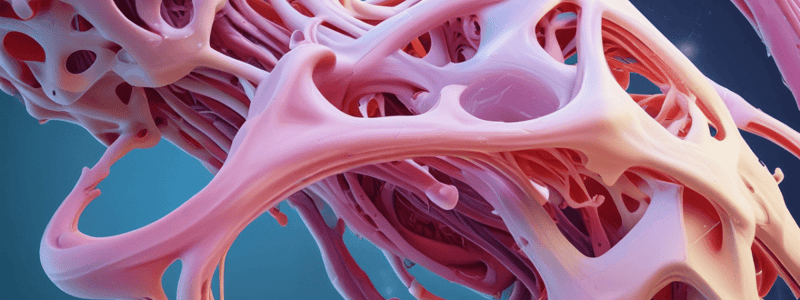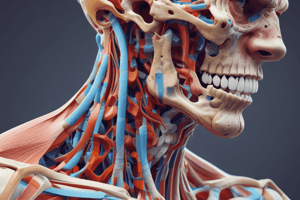Podcast
Questions and Answers
Symphysis is a type of fibrous joint.
Symphysis is a type of fibrous joint.
False (B)
Sutures can also be referred to as synostosis joints.
Sutures can also be referred to as synostosis joints.
True (A)
Gomphoses joints are found between two bones joined by an interosseous membrane.
Gomphoses joints are found between two bones joined by an interosseous membrane.
False (B)
Synovial joints allow minimal to no motion.
Synovial joints allow minimal to no motion.
Hinge joints are classified as uniaxial joints.
Hinge joints are classified as uniaxial joints.
Condyloid joints are considered triaxial joints.
Condyloid joints are considered triaxial joints.
Ball and socket joints are classified as triplanar joints.
Ball and socket joints are classified as triplanar joints.
Plane joints allow bones to glide on one another or rotate only in one plane.
Plane joints allow bones to glide on one another or rotate only in one plane.
Trochoginglymus joints are combined biaxial joints seen in the elbow and knee.
Trochoginglymus joints are combined biaxial joints seen in the elbow and knee.
Type II fibers are thicker and stiffer compared to type I fibers.
Type II fibers are thicker and stiffer compared to type I fibers.
Elastin fibers create a netlike interweaving of large fibrils.
Elastin fibers create a netlike interweaving of large fibrils.
Tissues with a high proportion of elastin do not return to their original shape after being deformed.
Tissues with a high proportion of elastin do not return to their original shape after being deformed.
Glycosaminoglycans (GAGs) attract water due to their positive charge.
Glycosaminoglycans (GAGs) attract water due to their positive charge.
Water does not play a role in providing a fluid medium for diffusion of nutrients within the tissue.
Water does not play a role in providing a fluid medium for diffusion of nutrients within the tissue.
Cells responsible for maintenance and repair in periarticular connective tissues confer significant mechanical properties on the tissue.
Cells responsible for maintenance and repair in periarticular connective tissues confer significant mechanical properties on the tissue.
Ground substance is a water-saturated matrix or gel where collagen and elastin fibers are embedded.
Ground substance is a water-saturated matrix or gel where collagen and elastin fibers are embedded.
Hyaline cartilage consists primarily of type I fibers.
Hyaline cartilage consists primarily of type I fibers.
The role of cells in periarticular connective tissues is to synthesize the specialized ground substance and fibrous proteins unique to the tissue.
The role of cells in periarticular connective tissues is to synthesize the specialized ground substance and fibrous proteins unique to the tissue.
Viscoelastic materials exhibit time-dependent properties.
Viscoelastic materials exhibit time-dependent properties.
If a material is exposed to high-stress levels for a long period of time, it experiences rapid deformation.
If a material is exposed to high-stress levels for a long period of time, it experiences rapid deformation.
Temperature changes do not affect the rate of creep in materials.
Temperature changes do not affect the rate of creep in materials.
To produce creep in connective tissue, one should use a large load over a short period of time.
To produce creep in connective tissue, one should use a large load over a short period of time.
Viscoelastic materials respond the same way to different rates of loading.
Viscoelastic materials respond the same way to different rates of loading.
When loaded rapidly, viscoelastic materials exhibit less resistance to deformation.
When loaded rapidly, viscoelastic materials exhibit less resistance to deformation.
The rate and duration of an applied force do not affect the deformation of viscoelastic materials.
The rate and duration of an applied force do not affect the deformation of viscoelastic materials.
Healthy tissues are always able to resist changes in their shape.
Healthy tissues are always able to resist changes in their shape.
Forces that move and stabilize the body have no potential to deform or injure it.
Forces that move and stabilize the body have no potential to deform or injure it.
In a saddle joint, each member presents paired convex and concave surfaces oriented at ~45° to each other.
In a saddle joint, each member presents paired convex and concave surfaces oriented at ~45° to each other.
The synovial fluid within diarthrodial joints increases friction.
The synovial fluid within diarthrodial joints increases friction.
Articular cartilage in synovial joints covers the bony surfaces to reduce wear and friction.
Articular cartilage in synovial joints covers the bony surfaces to reduce wear and friction.
The articular capsule encloses the synovial membrane in diarthrodial joints.
The articular capsule encloses the synovial membrane in diarthrodial joints.
Ligaments are sometimes associated with synovial joints.
Ligaments are sometimes associated with synovial joints.
Blood vessels are found within the articular cartilage of synovial joints.
Blood vessels are found within the articular cartilage of synovial joints.
Intraarticular discs or menisci help with force dispersion in synovial joints.
Intraarticular discs or menisci help with force dispersion in synovial joints.
Synovial plicae decrease the synovial surface area in joints.
Synovial plicae decrease the synovial surface area in joints.
Joint play refers to the amount of possible movement within a joint before the bones meet resistance.
Joint play refers to the amount of possible movement within a joint before the bones meet resistance.
Stress in a tissue that has experienced plastic deformation is recoverable in its entirety when the deforming force is removed.
Stress in a tissue that has experienced plastic deformation is recoverable in its entirety when the deforming force is removed.
Most healthy tendons fail at about 15-20% beyond their prestretched length.
Most healthy tendons fail at about 15-20% beyond their prestretched length.
The anterior cruciate ligament is typically strained about 5-6% during common activities.
The anterior cruciate ligament is typically strained about 5-6% during common activities.
Stiffness of a material is defined as the ratio of strain to stress within an elastic material.
Stiffness of a material is defined as the ratio of strain to stress within an elastic material.
Ultimate stress is the strain at the point of failure of a material.
Ultimate stress is the strain at the point of failure of a material.
Plasticity in a tissue occurs in Zone D of the stress-strain curve.
Plasticity in a tissue occurs in Zone D of the stress-strain curve.
The overstrained tissue experiences microscopic failure in the elastic zone.
The overstrained tissue experiences microscopic failure in the elastic zone.
Elastic deformation energy in a tissue is recoverable in its entirety when the deforming force is removed.
Elastic deformation energy in a tissue is recoverable in its entirety when the deforming force is removed.
Ultimate strain is the elongation at the point of failure of a material.
Ultimate strain is the elongation at the point of failure of a material.
Flashcards are hidden until you start studying
Study Notes
Classification of Joints
- Fibrous joints: held together by collagen, examples include syndesmosis, sutures, and gomphoses
- Cartilaginous joints: held together by fibrocartilage or hyaline cartilage, examples include symphysis and synchondrosis
- Diarthroses: synovial joints, allow for moderate to extensive motion
Synovial Joints
- Uniaxial joints: allow movement in one plane, examples include hinge and pivot joints
- Biaxial joints: allow movement in two planes, examples include condyloid and ellipsoid joints
- Triaxial joints: allow movement in three planes, examples include plane and ball and socket joints
- Combined biaxial joints: allow movement in two planes, examples include trochoginglymus joints
Biologic Materials
- Fibers: provide a flexible framework for maintaining shape and consistency, examples include type II fibers and elastin fibers
- Ground substance: a water-saturated matrix or gel, composed of glycosaminoglycans and water, which provides a fluid medium for diffusion of nutrients and assists mechanical properties
- Cells: responsible for synthesizing specialized ground substance and fibrous proteins, and maintenance and repair of tissue
Properties of Connective Tissue
- Viscoelasticity: exhibits time- and rate-dependent properties, sensitive to duration and rate of force application
- Time-dependent properties: creep, deformation that occurs when a material is exposed to high-stress levels for a long period
- Rate-dependent properties: responds differently to different rates of loading, exhibits greater resistance to deformation with rapid loading
Forces on Musculoskeletal Tissues
- Forces that move and stabilize the body can also deform and injure the body
- Healthy tissues resist changes in shape, weakened tissues may not be able to resist forces
Elements of Diarthrodial Joints
- Always associated with joints: synovial fluid, articular cartilage, articular capsule, synovial membrane, ligaments, blood vessels, and sensory nerves
- Sometimes associated with joints: intraarticular discs or menisci, peripheral labrum, fat pads, bursa, and synovial plicae
Joint Kinematics and Kinetics
- Osteokinematics: describes motion of bones relative to the three cardinal planes of the body
- Arthrokinematics: describes motion between articular surfaces of joints
- Kinetics: describes axial translatory forces, including compression and tension
Mechanical Behavior
- Stress-strain curve: zones A-E, with zone C being the plastic zone, where tissue experiences permanent deformation
- Stiffness: ratio of stress to strain within an elastic material, defined by Young's modulus
- Failure: occurs when a structure can no longer support a load, including ultimate stress and ultimate strain
Studying That Suits You
Use AI to generate personalized quizzes and flashcards to suit your learning preferences.




